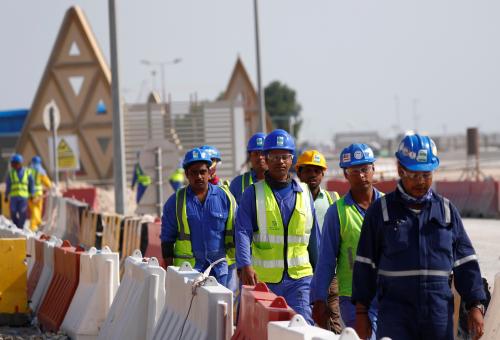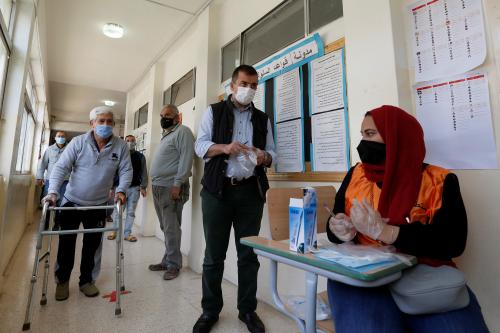Content from the Brookings Doha Center is now archived. In September 2021, after 14 years of impactful partnership, Brookings and the Brookings Doha Center announced that they were ending their affiliation. The Brookings Doha Center is now the Middle East Council on Global Affairs, a separate public policy institution based in Qatar.
It is often said by people in the Middle East, especially Israelis and Palestinians, that “in the end, we always come back to the Arab-Israeli conflict.” That is exactly what happened on Thursday, May 19, when U.S. President Barack Obama delivered a major policy speech at the State Department, introducing new principles for negotiations based on 1967 borders, and this past weekend, when at least 10 unarmed protesters were killed by Israeli fire on a day the Palestinians call the “Nakba,” or “Catastrophe.” The Arab-Israeli conflict is once again front and center.
But if the broad brush strokes of this story are by now painfully familiar, the context and the particulars of this week may point to a different kind of flare-up while the United States seeks to restart peace talks. There is, of course, the Arab Spring: The Palestinians see the new narrative of the Arab revolts for greater freedoms, justice, and equality joining their own decades-old search for the same, and for a state of their own. For Israelis, Sunday, May 15, was the day when the Arab awakening washed up on their own still provisional borders, reminding them yet again of how vulnerable they are and how isolated they have become.
Coordinated protests on Israel’s 1949 armistice lines with Syria and Lebanon — as well as in the West Bank, Gaza, Egypt, and Jordan — have alarmed many Israelis and raised concerns that Israel lacks the practical means to counter mass demonstrations in the future. In fact, only a heavy security presence near the Egyptian and Jordanian borders with Israel prevented protesters from besieging these areas as well. Israelis are realizing the tangible effects of a rapidly changing region in which old certainties are dying and fears of a return to conflict are revived.
Palestinian refugees, meanwhile, used the tools of today’s revolutions — the Internet in general and Facebook in particular — to organize protests and assert their right to return to their homes in what is now Israel. An estimated 600,000 Palestinians are on Facebook in the West Bank and Gaza alone, and nearly one-third of them are thought to be politically influenced by social media. When Fatah and Hamas finally signed a reconciliation agreement two weeks ago in Cairo, they were responding in part to a campaign for Palestinian unity organized by Internet activists that had managed to mobilize thousands in both the West Bank and Gaza. Emboldened by these developments, activists are organizing more mass protests and marches to pressure Israel, the international community, and their own leadership as the Palestinian-imposed deadline for statehood approaches in September.
What made this year’s Nakba Day all the more remarkable, though, were the events along the Syrian-Israeli de facto border. Thirty-eight years of near-total calm along the nearly 50-mile frontier were shattered as dozens of Palestinian protesters trampled their way through the security fence into the Israel-occupied Golan Heights. The event marked a failure for Israeli intelligence and the military and showed the impotence of the 1,250-member United Nations observer force established to monitor the 1974 Separation of Forces Agreement. It also showed that Bashar al-Assad’s Baathist regime is ready to export instability if necessary, especially to Israel; given the degree of restrictions on movement in the area, it is inconceivable that the protesters could have reached the security fence without the acquiescence and participation of the Syrian authorities and security forces.
With the situation in Syria likely to worsen in the weeks ahead, was the breach a power play from a regime determined to reinforce the point that only it can ensure stability? Or was this a means of diverting attention from Syria’s own crackdown and bolstering Assad’s credentials as a resistance regime against Israel? In fact, it was likely both. The move may have backfired, however, leading Israel’s military to conclude that Assad and his regime cannot be relied upon to deliver calm along their sensitive border. With May 15’s events, the assertion that only with Assad comes stability and after him there is chaos has already been turned on its head. This is the moment for the international community to send a clear signal that it will not tolerate being blackmailed by the Assad regime, especially when the region’s stability and security are at stake.
Obama’s speech on Thursday proved that American and Israeli leaders can put off talking about these issues, but not for long. The president’s mention of the 1967 borders as a basis for talks with the Palestinians provoked a sharp response from Prime Minister Benjamin Netanyahu even before he got on the plane to Washington, where he is due to meet with Obama May 20 and speak to a joint session of Congress on May 24. Netanyahu rejected Israel’s withdrawal to such “indefensible” borders. As Haaretz columnist Aluf Benn opined in his recent editorial, Netanyahu’s aim is to bolster Israel’s defenses against the third intifada — not present major concessions.
By offering ideas on future security arrangements for a demilitarized Palestinian state as well as borders, Obama has finally laid out parameters on two of the four main issues (the others being Jerusalem and refugees) of the conflict. He also stressed the importance of a contiguous and viable Palestinian state that borders Egypt and Jordan, but rejected the idea that Palestinians could establish a state through a vote at the United Nations in September.
The problem is that these ideas have come two years too late. The parties aren’t speaking to one another, and their last attempt to do so only showed how far apart they are. There are also serious doubts as to whether the U.S. president has the political will and political strategy to push both Israelis and Palestinians as he campaigns for reelection. At best, Obama has pressed another reset button in order to start talks. He has not explained a clear way forward other than a vague call for the United States, the Middle East quartet, and Arab states “to continue every effort to get beyond the current impasse.” Meanwhile, Palestinian leaders, particularly President Mahmoud Abbas, feel freed by the Palestinian unity deal and will likely pursue their efforts for recognition of a Palestinian state at the United Nations if serious negotiations do not start soon — despite Obama’s explicit rejection of this move.
This year’s changes in the Middle East and North Africa have had a profound impact on the prospects for peace in the region. The people of the Arab world are no longer willing to play by the old rules, in which peacemaking is determined by Israel’s security concerns and the United States’ electoral calendar. There is a growing impatience to ensure justice for the Palestinians and a state of their own. Serious moves are required, therefore, to establish two states, Israel and Palestine, this year. The situation requires a new international effort similar to the Madrid conference that followed the first Gulf War in 1991. Back then, it was U.S. leadership that brought new impetus to achieve peace between Arabs and Israelis. This time, clear parameters on borders and security arrangements, as presented by Obama on Thursday, as well as the other core issues, could provide the basis and impetus for a final-status deal.
Failing that, the relevance of both Israeli concerns and American efforts will continue to recede as the Palestinians seize the initiative in an environment dictated by Arab popular will. It promises to be a long, hot summer in the Middle East.



Commentary
The Middle East Crisis That Just Won’t Go Away
May 20, 2011